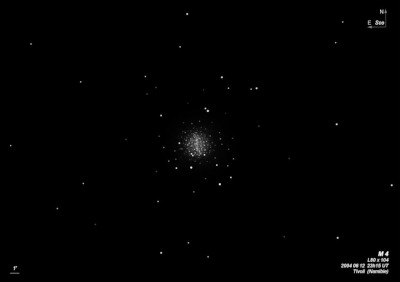
Philippe de Chéseaux discovered M4 = NGC 6121 = Lac I-9 in 1745-46. Nicolas-Louis de Lacaille found it again in 1751-1752 with a 1/2" telescope at 8x during his expedition to the Cape of Good Hope. William Herschel didn't catalogue M4 as he tried to avoid repeating the Messier objects but described M4 as "a rich cluster of considerably compressed small stars surrounded by many straggling ones. It contains a ridge of stars running through the middle from south preceding to north following. The ridge contains 8 or 10 pretty bright stars. All the stars are red." He noted in his 1814 publication that the observed red color was probably owing to the low elevation of M4, though there is one conspicuous red star in the bar. John Herschel has no entry in his Cape of Good Hope catalogue, though he undoubtedly observed this showpiece.
200/250mm - 8" (6/19/82): superb resolution of mag 11-13 stars.
300/350mm - 13.1" (6/19/82): the core is beautifully resolved including the bar which resolves into a number of faint stars. The halo is fully resolved with many star lanes.
400/500mm - 17.5" (7/4/86): very bright, very large, 15' diameter. Resolved into an extremely dense swarm of several hundred stars with many stars arranged in strings. Appears fully resolved at moderate power including the distinctive bar extending N-S through the center. M4 is possibly the closest GC at a distance of 5600 light-years.
600/800mm - 24" (8/16/12): M4 displayed several orange/red supergiants, including the brightest star (mag 12) within the central bar. This star is situated at the northern intersection point of the bar and the partial oval ring of stars that extends mostly to the east of the bar. Another orange star is on the southwest side of the core, 4' from center. A bright, orange mag 10 star is on the SSW side of the halo, 6.5' from center. A wide, bright pair of orange stars (10.8/10.9 at 17") is SE of the bar (1.8' from center).
Notes by Steve Gottlieb